How to remove iron marks on clothes?
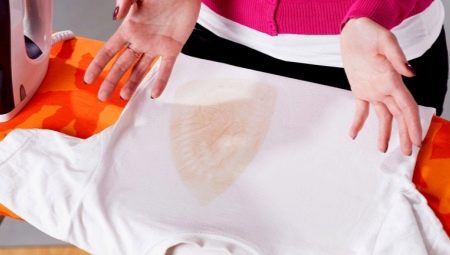
If the temperature is set incorrectly when ironing, then quite often unpleasant stains and yellow tan marks appear on clothes, bedding and blankets. However, this can happen due to banal carelessness. But if the hostess burned the trousers or shirt on, this does not mean that the thing is completely ruined, in most cases it can be saved and the clothes can be returned to their original color.
Causes of tan marks
The main causes of markings are as follows:
- violation of the basic rules of heat treatment of things;
- illiterately selected ironing temperature for various types of fabrics;
- lack of care for the ironing surface of the iron and the board, which leads to contamination of products at the time of ironing;
- insufficient rinsing of things - in this case, when a hot iron comes into contact with the remains of washing powder, the latter begin to "burn", which causes the appearance of rather unaesthetic stains.
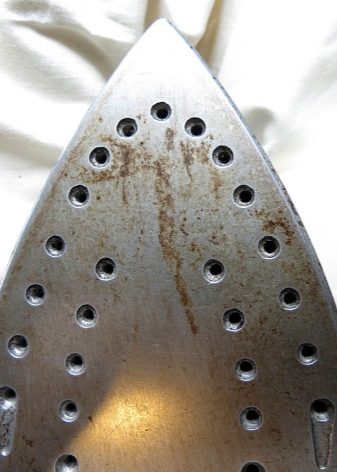
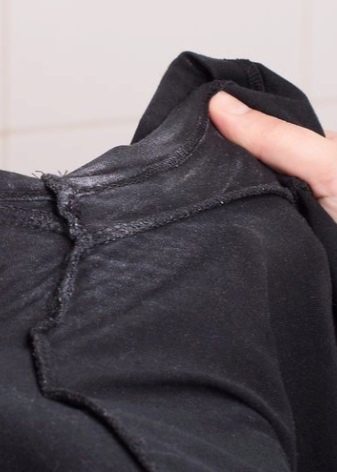
Gloss often appears on fabrics of black and dark shades. - shiny traces from a hot iron on the surface of the material. On lighter linen, tan marks are formed, they are yellowish and less often brown.
There is no universal recipe that will allow you to remove stains from any items without leaving a trace. Much depends on the type of fabric, composition and thickness of the fabric. The older the stain, the more difficult it is to get rid of it completely. And, of course, if you have a brown stain in front of you, then it is almost impossible to save such a thing - in this case, the fibers of matter are damaged and there is no technical possibility to restore them.
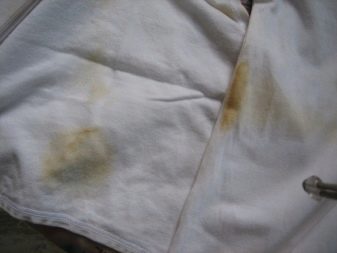
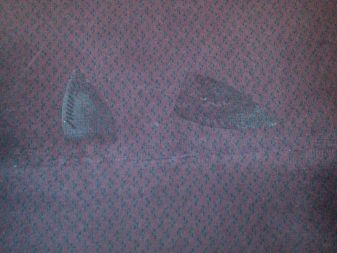
How to effectively remove stains from fabric?
Regardless of the reason for the appearance of a trace from the iron on the canvas, the first thing to do is to prevent the particles of burnt fibers from penetrating deep into the material, so the thing must be immediately washed thoroughly under running water, then the washing powder is gently rubbed into the stain or any liquid detergent and rinsed again.
Keep in mind that in this case the water should be cool, since hot, on the contrary, will further penetrate the stain into the depth of the material.
In some cases, such processing is sufficient, but more often than not, a number of additional measures should be taken to save the beloved thing.
Regardless of which method you choose, you first need to process the finished material in an inconspicuous area and wait a few minutes. If the fabric has not corroded during this time, and the color has not faded, you can safely use the selected preparation.

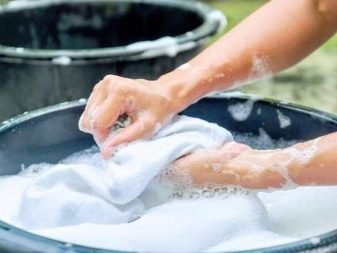
Black
In order to remove stains from dark cloths, as a rule, borax, vinegar or alcohol are used.
Alcohol is optimal for removing burn marks on viscose products. To do this, the stain must be treated with alcohol and held for about 60 minutes, then rinsed thoroughly under cool running water.
Vinegar is used in a slightly different way: moisten a piece of cloth or a cotton pad with it and thoroughly wipe the contaminated area, leaving it until the odor has completely disappeared. After this treatment, the product is ironed with an iron.
To use a borax solution, you need to dilute 1 spoon of the drug in a glass of water and then wipe the stain with this mixture. When the treated area is dry, you should wash the thing on a typewriter in the standard mode.
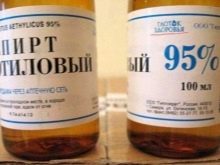
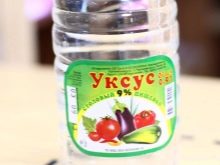
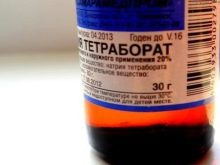
Be sure to keep in mind that these options are only used for synthetic fabrics.
For satin or flax, slightly different recipes work. So, a shiny trace is well removed with a mixture of salt and ammonia (15 g each), dissolved in 2 liters of cold water. The fabric is treated, left for half an hour, then washed in warm water and gently ironed through cheesecloth.
Vinegar can also be used for these fabrics, but in this case it is diluted with water in a ratio of 1 to 1, a thin light cloth is soaked in the resulting solution, applied to the damaged area and gently ironed, while the iron itself is not pressed strongly.
Laundry soap can also help combat ugly shine on black items. In this case, rub it on a coarse grater, add a little ordinary water and dissolve it, then use it in the same way as in the above case - soak a piece of gauze in the solution and iron the spoiled thing through it.
Some housewives iron the shiny tan through the newspaper - this method also works, especially when it comes to black fabrics.



One of the fastest and most effective stain removal methods is the use of tea leaves. Tea must be loose, tea bags are not suitable here. For processing, the damaged areas are treated with tea, and then they are looked at with a hot iron.
In the fight against yellow markings, tools such as a file, a pumice stone, or even a razor can be of great help. The damaged areas are carefully "shaved" or "filed", but try not to overdo it, otherwise you will easily get a hole.
If the fabric is very delicate, you can try using a regular school eraser.
If a cotton and wool canvas is damaged, then first try to save the thing by rubbing the stained area with a damp cloth. If the footprint is small, then it is quite possible that it will disappear.
If the tan is large or the item is too expensive, then it makes sense to resort to dry cleaning services.
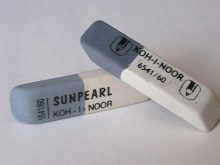
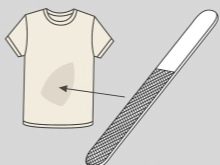

White
It is much more difficult to remove tan marks from white fabric. Lemon juice is considered one of the most effective remedies.The damaged area is treated with juice, and then generously sprinkled with powdered sugar. As soon as the treatment site is dry, the item should be washed in cold water.
Hydrogen peroxide is quite effective, which is poured onto a clean cloth and gently wiped over the stained area of the cloth. After the treated stain dries, the product should be washed.
Baking soda can also be a good helper. The stain should be moistened generously and then sprinkled with baking soda as well. When it is all absorbed into the material, rub the stain with the hard side of the sponge, then rinse thoroughly. The procedure can be repeated several times until the spot disappears completely.
Table salt gives a good result. The processing technique in this case is the same as with soda.

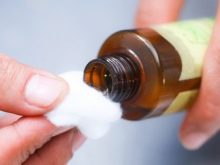
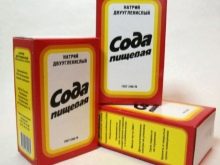
Some housewives use milk. They spill it over the stain and when it dries, the stain often disappears. For the same purpose, quite often they take yogurt or sour milk. It is diluted with water in a ratio of 1 to 2 and the soiled thing is soaked for several hours to completely disappear the stain.
If the iron has left deep stains on the white fabric, bleach can handle this.however, this product is quite caustic, so gloves and a gauze bandage should be worn when working. To prepare a cleaning suspension, 5 g of bleach is diluted in a liter of heated water and the soiled thing is soaked in this solution for 5-7 minutes, then the product is straightened and the stain is poured with a concentrated solution of chlorine. In this form, the product is left for 15 minutes, then rinsed in a large volume of water.
It should be borne in mind that this option is used only for cotton fabrics; using it on artificial fabric and wool will simply damage the material even more.
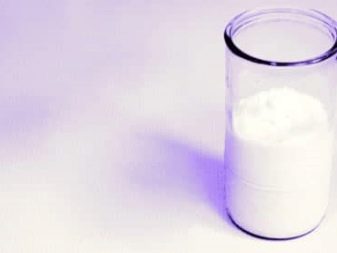

Color
If the item is colored, then you can use regular onions. It is rubbed on a grater, and the resulting gruel is applied to the contaminated area for 30-70 minutes, after which the item is rinsed. Instead of gruel from grated onions, you can also use squeezed juice - it is rubbed into the canvas, and the fibers of the material literally "push out" the burn in half an hour.
Keep in mind that the onion scent will take a long time to fade away, so you may need to wash it a few times to get rid of this particular scent.
There is one small "but" - the method is good only if the stain is fresh. When scorch marks "decorate" a thing for quite a long time, it is hardly possible to save it.
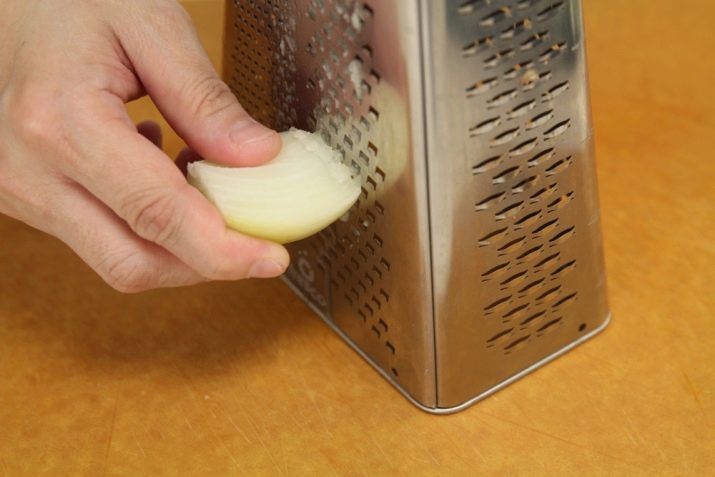
What if you burned a thing?
Sometimes, after using the iron, dark brown or even black marks remain on the products. The reasons for this may be the mistress's forgetfulness, an incorrectly set processing mode for the canvas, or dust that has got into the water tank, which comes out with steam and stains things. And if in the latter case, to get rid of the stain, you only need to wash the fabric, then in the first and second it is almost impossible to remove the ugly stain. However, you can try to give the product a second life.
First, brush over the stain with a toothbrush to completely remove any burnt fibers. You can also moisten the stain with lemon juice, then rub the tan with a nail file or a sharp knife. The pellet machine removes damaged fibers very well - all you need is just to walk it over the damaged area of matter.
Keep in mind that these options are only good for dense materials, as other fibers will remain after removing the damaged layer. If you burned the thing to the holes, then you can sew a patch or apply an original applique to this place.


In stores that sell sewing accessories, there is a wide selection of applications of various shapes and shades, they can be made from a wide variety of fabrics and often look like embroidery.Most appliqués have a sticky bottom layer that can be applied without using a needle and thread.
Appliques are applied to cotton fabrics with an iron. The surface to be treated should be cleaned of dirt, dust and debris. The place where you plan to apply the picture is carefully ironed with an iron and cooled. The bottom layer is removed from the thermo-application, which protects the adhesive surface. It must be pressed against the canvas and covered with a hot iron for 5-7 minutes, after which the product should be ironed and the upper protective layer of the picture removed.
For delicate and synthetic fabrics, such options are unacceptable - here applications and patches can only be sewn on.


Precautionary measures
It doesn't matter if you have damaged some old unnecessary thing, but the burn marks on jackets, skirts or blouses deliver a lot of unpleasant moments to their mistresses. To minimize the risk of such damage, there are a few tips to follow:
- when ironing things, be sure to use an iron;
- if possible, it is better to iron the product from the wrong side;
- ironing temperature should be set in accordance with the type of material;
- after washing, each product should be rinsed out as best as possible;
- monitor the condition of the soleplate of the iron - it must be extremely clean, without carbon deposits and adhered objects.
Of course, the trace from the iron is much easier to remove if it is fresh. That is why decisive measures should be taken as soon as the stain appears on the product. Any of the above methods can help, but only if the work is done on time.
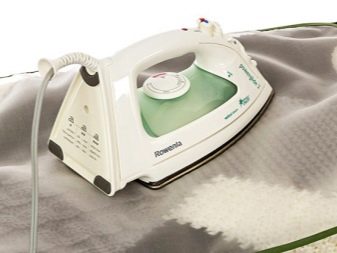
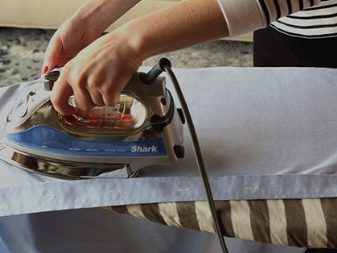
After buying a new thing, be sure to study its label, it must indicate the temperature at which it needs to be ironed. Usually for synthetics, lower temperature conditions are set, and for jeans, linen and cotton - increased.
If you have made a stain, be sure to inspect the cooled iron soleplate - most likely, there are burnt fibers of material adhering to it. They should be removed and the remaining stain cleaned, otherwise the iron will stain all things during subsequent ironing.
And, of course, do not iron your favorite dress on a sofa or carpet - in this case, the stains cannot be fixed.
For information on how to remove iron marks on clothes, see the video below.








